I've been wanting to do a series of posts entitled Baking Basics for a long time, because I know that I only started seriously baking (or rather, baking anything at all) since last December and since then I do believe I've improved by leaps and bounds and I know that this invaluable experience should be shared, so that other novices like myself can learn and not commit the mistakes I did, and at the same time, have in their repertoire basic recipes for anything. BUT, I somehow never got around to doing it because ... I don't know why. I have many of such posts saved as drafts on my dashboard but none of the photos I took made the cut. I figured that number 1, with the insane number of photos I took of my process making my pastry cream, or crème pâtissière, there was a higher chance of nicer photos and number 2, since I'm hosting Aspiring Bakers #10: Easy as Pie (August 2011), and many would be attempting tarts, it would be selfish of me not to share this wonderful recipe that I love.
This recipe is from my pastry idol, Pierre Hermé. I've tried a number of his recipes including puff pastry, macarons, mousses, and he has never failed me. I have tried quite a few recipes for pastry cream, mainly because I make a small amount each time (see the one by Donna Hay here), but I find myself returning to this recipe time and again. I especially like the silkiness and lightness of this cream.
Anyway, to share a little bit of happy news, I've also started taking up French lessons, which has been a dream of mine since forever! I've always wanted to learn French, in fact I still remember when I fell in love with the language - it was the first time I heard French being spoken in Switzerland. The fascination continued when I actually stepped foot into Paris and the rest of France. And the fascination has grown. I love the culture, the food (especially the pastry!), the romanticism of the language and especially the history. Although France is no longer the superpower that it once was decades ago, singlehandedly building up the European Union with the other 'pioneer members', vestiges of France still remain - you see it in the bakeries in Vietnam and the straight wide roads in Cambodia.
So, digression aside, I actually translated the recipe below (just the ingredients since the method is entirely in my words) from the French tome which I'd bought earlier this month. My dad called it counting my eggs before they're hatched, but I call it a culmination of a childhood dream. Having a huge expensive French book lying around and me unable to understand it just forces me to want to know more French, so that I can understand and unlock the mysteries of the recipes before me. I know it'll be some time before I'll be able to read or write fluently, but I know I'm getting there, and for that, I'm really happy that I finally bit the bullet...after a decade of procrastination. (Really, I myself can't believe it's been 10 years?!) Previously I didn't have the money nor the time to learn, but now that I do (not really actually but who cares, I'll fit it in anyhow), no one's going to stop me! In fact, if I'm lucky, I just might be able to visit Paris again sometime this year or next, so I'll have opportunity to practice my French!
Till then, here's the step-by-step (kinda) photographic method followed by the somewhat bastardized version of the recipe below!
This recipe is from my pastry idol, Pierre Hermé. I've tried a number of his recipes including puff pastry, macarons, mousses, and he has never failed me. I have tried quite a few recipes for pastry cream, mainly because I make a small amount each time (see the one by Donna Hay here), but I find myself returning to this recipe time and again. I especially like the silkiness and lightness of this cream.
Anyway, to share a little bit of happy news, I've also started taking up French lessons, which has been a dream of mine since forever! I've always wanted to learn French, in fact I still remember when I fell in love with the language - it was the first time I heard French being spoken in Switzerland. The fascination continued when I actually stepped foot into Paris and the rest of France. And the fascination has grown. I love the culture, the food (especially the pastry!), the romanticism of the language and especially the history. Although France is no longer the superpower that it once was decades ago, singlehandedly building up the European Union with the other 'pioneer members', vestiges of France still remain - you see it in the bakeries in Vietnam and the straight wide roads in Cambodia.
So, digression aside, I actually translated the recipe below (just the ingredients since the method is entirely in my words) from the French tome which I'd bought earlier this month. My dad called it counting my eggs before they're hatched, but I call it a culmination of a childhood dream. Having a huge expensive French book lying around and me unable to understand it just forces me to want to know more French, so that I can understand and unlock the mysteries of the recipes before me. I know it'll be some time before I'll be able to read or write fluently, but I know I'm getting there, and for that, I'm really happy that I finally bit the bullet...after a decade of procrastination. (Really, I myself can't believe it's been 10 years?!) Previously I didn't have the money nor the time to learn, but now that I do (not really actually but who cares, I'll fit it in anyhow), no one's going to stop me! In fact, if I'm lucky, I just might be able to visit Paris again sometime this year or next, so I'll have opportunity to practice my French!
Till then, here's the step-by-step (kinda) photographic method followed by the somewhat bastardized version of the recipe below!
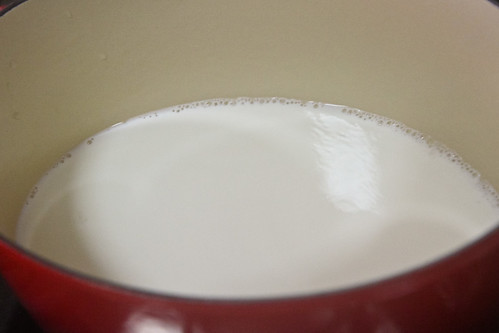 |
| In a saucepan, heat up your milk until it boils. |
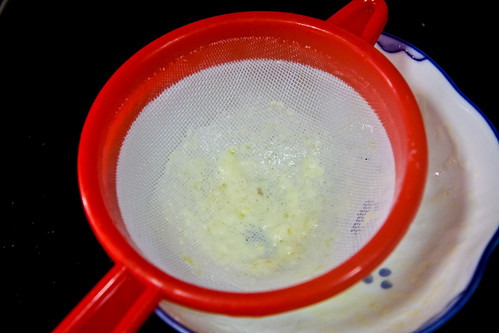 |
| Having whisked it all the boiling milk, strain the mixture back into the saucepan. See the scrambled bits left on the sieve! |
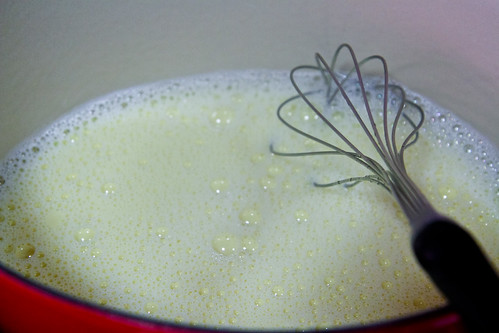 |
| Continue whisking the mixture again, bringing it up to a boil. |
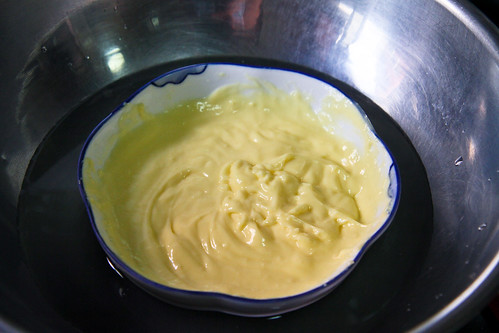 |
| Remove the mixture from heat the moment it reaches this texture. I placed the mixture into a bowl and into the ice bath to stop the cooking. |
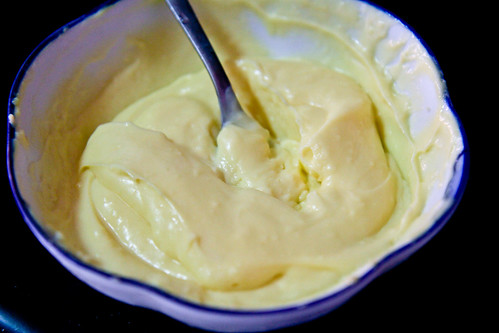 |
| This is the mixture after adding the butter. See that the mixture is lighter in color and slightly thicker than the previous photo. |
And here's what NOT to do. The white balance in the photo is a little off because I had to take it with flash and it's really blur since it's my phone photo. Anyway, this is the result if you try to speed up the process by using a medium-high heat - which is an absolute NO-NO because the pastry cream thickens way too fast for you to control the heat and it basically just clumps like what you see below. Now you know!
 |
| Fully cooked eggs in the pastry cream :/ |
Pastry Cream
Makes 2½ cups or 900 g
Translated from La Larousse du Chocolat by Pierre Hermé
2 cups (500 g) whole milk
4 egg yolks (about 80g)
6 tbsp (75 g) granulated sugar
3 tbsp cornstarch, sifted
2½ tbsp (40 g) unsalted butter, at room temperature
½ tsp vanilla extract
Method:
- In a small saucepan, bring the milk to a boil.
- In another bowl, combine the yolks, sugar and cornstarch together and whisk well.
- Once the milk has reached a boil, temper the yolks by whisking in a small portion of the boiling milk into the yolk mixture.
- Continue whisking in the rest of the hot milk into the tempered yolk mixture.
- Strain the mixture back into the saucepan using a sieve to remove any scrambled bits of egg.
- Heat the saucepan over a medium fire and whisk vigorously until the mixture returns to a boil. Continue whisking for 1-2 more minutes over medium heat until the cream thickens. You will notice your whisk leaving trails in the cream. Once the cream has thickened, take it off heat and pour it into a bowl in an ice bath to stop it from thickening further. Continue whisking the mixture until you get a smooth mixture.
- Once the cream has cooled to about 30°C (use your finger to test and it should be slightly warm – around your body temperature), slowly add in the cubed butter gradually in a few portions and stir in the vanilla extract.
- Once the butter is fully incorporated, cover it with plastic wrap and store it in the fridge until you are ready to use it. Make sure the plastic wrap touches the surface of the cream so that a film will not form over it.
Janine's jots:
- Taste: I like the small addition of vanilla and I find it indispensable because I'm not an avid fan of an eggy test. HOWEVER, I do have to say that the addition of the butter does help and I've tried skipping out on the vanilla and the cream doesn't taste as eggy as other recipes.
- Texture: Silky, smooth, creamy, what more should I say?
- Serving size: What you see above is the full recipe which I actually seldom follow since I don't bake that much anyway. I have tried halving and quartering the recipe and it stills works perfectly! A word of caution though, make sure you use an appropriately sized saucepan for the smaller amounts otherwise it'll be pretty hard.
- Modifications: None really.
- Storage: This can be made 2-3 days in advance and stored in the fridge. I do not advance freezing it or keeping it for more than a week in the fridge.
- Would I make this again?: Definitely - it's my go-to recipe for pastry cream and I've been using it in tarts, in profiteroles, eclairs, etc!
PS: If you've read till this part of the long post, thank you! I tend to write rather lengthy sentences sometimes and I apologize!

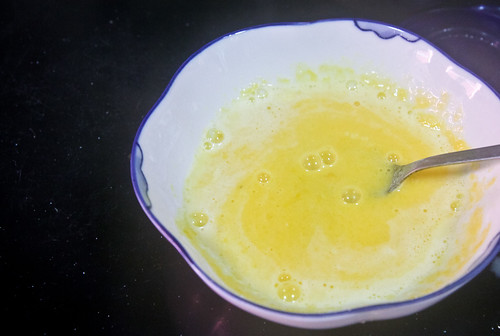
5 comments:
Thanks for sharing all these valuable tips in making this delicious pastry cream. Very nice to know the ones those with your personal experiences.
Hi Janine, thanks for translating sharing this recipe. I like that this recipe doesn't use too many egg yolks.
@Zoe and sotong: no problem :) do try it out someday!
Hey Janine!
I am not sure if it will actually work, but the overcooked pastry cream actually reminds me of custard "paus". So if we actually overcooked it. maybe we could do that? haha.
@Jacob: hehe actually pastry creme is what goes into the custard buns, but you need cooled pastry creme and not the overcooked one - the overcooked one just coagulates and it tasted like crap when I ate some of it, it's very gritty and there's large chunks of cooked egg yolk. If you use that in your buns, it'll be really :/
I'd say that the custard in the custard buns are the thicker version of the pastry creme thanks to the heat but not to the extent that I overcooked it to hehe. If
Post a Comment